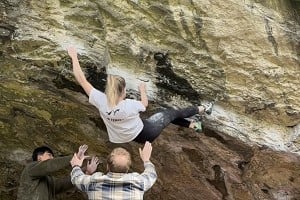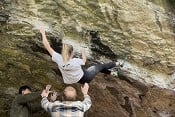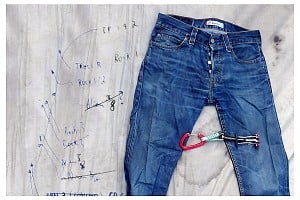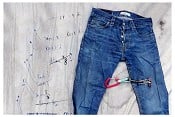
Looks like an Eternal Fall indeed.
Do you find sandstone in the Ogwen? I was under the impression you don’t and that this is probably dole rite but I am not a geologist…
We were wondering about this exactly. It looks and feels pretty much exactly as sandstone does, there’s a crag further up the Ogwen called “Carreg Mianog”, which is apparently sandstone.
I believe “Isle of Wonder” and the nearby “Snapdragon” also seem to be the same sandstone like rock. But I do agree that it could also potentially be a type of dolerite.
There is sandstone and siltstone in the bottom of the Ogwen valley, according to this:
Very useful! Thank you Andy.
Just looking at it, I can pretty confidently say it is not sandstone and is almost certainly volcanic rock, possibly rhyolite or some sort of tuff. Nice highball. Why did you give it an E9 trad grade instead of font 7B+? It seems like you did it in a bouldering style.
Turns out a lot of what I’d taken to be extrusive volcanics in Snowdonia is actually extrusive volcanics sourced sedimentary rocks, which would explain the differences in textures of places like Lily Savage to somewhere like the Killer Weed boulder.
I’m afraid to say that you’re wrong Chris. Refer to the link that Andy attached, it’s almost certainly sandstone.
Style is out of the picture for something like this. Yes, I used bouldering pads but these certainly do not guarantee safety. The way I see it, falling off isn’t an option once you’ve done the first crux move. Therefore it’s not a boulder problem.
The problem is characterised by bold climbing in relation to the difficult climbing, so it’s more fitting to use the English grading system in this scenario in my opinion. No different to Simbas Pride. Go onto my Instagram account for explanations. Mat_wright1998
> I’m afraid to say that you’re wrong Chris. Refer to the link that Andy attached, it’s almost certainly sandstone.
You're very good at bluffing... you didn't seem so confident upthread... and it doesn't look like sandstone! Let's see what someone who knows what they're talking about says on the matter
> Let's see what someone who knows what they're talking about says on the matter
Like the British Geographical Survey?
The map shows sandstone, Mat says it feels like sandstone... but we should probably go with the confident view of C Witter, who's looked at a photo
Allthough I cant comment on this particular outcrop, volcanic rock in Snowdonia is a real mix of things, essentially you had a load of volcanoes adjacent to a sea so you get a continuum from lavas and pyroclastic rocks, near volcanic centres, ashfall deposits and tuffs a bit further away and where these explosive deposits extended into marine areas they were then reworked by debris flows and undersea currents. So essentially you can get "sandstones" which are basically reworked volcanic rocks to variable extents. The composition of the tuffs etc.. will be identical but you might see some bedding and grading/sorting. Weather you define these as sandstones, volcanolclastic sandstone or tuffs essentially depends on how many sedimentary features you can spot.
Anything for an argument ai Chris 😉
Dunno about that specific rock, but I know of an absolutely ginormous sheet of gritstone (yes... honestly... and it's lovely and quiet so I'm not naming it, so there!) only just round the corner from there with beautiful trilobite fossils and lovely waves in it. Snowdonia is massively varied over very short distances
I've climbed on grit up at Marchlyn Bach (Bronllwyd Grit to be precise).
Good little trio of routes in Perrin's Prow (E6 6b), Western Grit (VS 5a) and Micronesia (E5 6a). I doubt there's much risk of it becoming less than quiet.
Chris, have you seen the size of it? Not exactly Blackstone edge 🤣
Yep, so that stuff is essentially deep marine debris flows (turbidites) that overlies the slate, a bit older than the volcanics. Very basically you had had a deep marine basin in the cambrian with the mud stones of the slate and these debris flows deposited (where thick unstable accumulations of sediment at the basin margins collapsed) then into the ordovician the basin shallowed and you got various volcanic rocks and reworking in shallow(ish) waters.
I'm a competent amateur geologist and that rock does not look like sandstone. Sandstone weathers in a specific way, meaning angular edges are uncommon. There is also some grey/green hues in the rock (more typical of metamorhpic/igneous), and little in the way of sedimentary type layers. However, could easily be wrong.
The way sandstone weathers is very much dependant on the cement. These sandstone will be heavily silicified and also variably metamorphosed they will also be comprised of very high amounts of volcanic material that hasn't been 'worked' by rivers, currents ect... to any great extent. Therefore a blocky texture, due to development of a metamorphic fabric and various different coloration from minerals like chlorite would be expected.
It's all in here if you want to get the details https://pubs.bgs.ac.uk/publications.html?pubID=B01562
But as I said up thread the difference between these sandstone and tuffs/pyoclastic deposits can be splitting hairs sometimes.
Interesting - thanks!
Thanks for the vote of support Andy
This is UKC, Mat - this is merely a bit of polite debate! Well done on a hard ascent. I hope this impressively towering lump gets repeated soon, despite being overlooked by many keen locals.
First of all, well done to Matt. It's an awesome looking line, regardless of the grade, but does also look very hard and bold.
As to the geology: the only scientific way to determine the rock type is to visit the line of rock climbed with a proper geological hammer and remove samples from all the way up the line. Samples from off the line are of no use. The samples then need to go to a lab for full analysis of the geochemistry and spectral analysis of the mineral content.
It's the only logical way .
> I'm a competent amateur geologist
I'm very much not but...
> Sandstone weathers in a specific way, meaning angular edges are uncommon.
Aren't all the classic American desert cracks - like in Indian Creek, sandstone? Wingate sandstone in particular? Many of those cracks look like they are cut by a razor - and are super angular. Much more so than granite for example.
As commented upthread, the geology of the Ogwen Valley is a mixutre of igneous (both intrusive and extrusive) and sedimentary rocks.
As the sedimentary rocks (predominantly sandstones) mainly source from the volcanic deposits, they have similar compositions to the igneous rocks in the area and thus can be hard to distinguish.
There are two primary ways differentiating between the sedimentary and ignous rocks: colour and grain structure.
The igneous rocks are largely comprised of rhyolites (very finie grained igneous rocks with a granitic composition), which weather to a very pale colour (almost white) due to their high feldspar content. The sandstones are much darker, weathering to a brown colour. Little Tryfan is comprised of sandstones; if you look at, and comapre it to, the rocks higher on the main Tryfan summit (which are igneous) they are a notably different colour (whiter, paler) to little Tryfan.
A subtler difference is the grain structure of the two different rock types when viewed close up. The igneous rocks (both ashfall derived and from lava flows) have a predominantly black fresh surface, with angular pale white flecks embedded in it. The pale flecks are likely to have no consistent orientation. The sandstones have a more uniform appearance, as the grains were deposited in an aquatic environment which caused material grading, opposed to the more chaotic and higher energy formation of the volcanic rocks and sediments.
Of all the things I thought I was going to learn in this thread,a lesson about geology wasn't one of them. Whilst a little off topic it's been truly fascinating, so thanks to both yourself and ebdon for the enlightening posts.
Congrats also to Mat for the FA
All good points.
I guess it’s due to the type of matrix and method of weathering.
I’m defo an amateur having read that ! Ta.
Thank you Rob! 🙏
> Like the British Geographical Survey?
> The map shows sandstone.
If it is a boulder rather than part of the bedrock (I don't know if it is) then would it show up on the geological map if it were, say, a rhyolite boulder deposited by a glacier or fallen off the mountain?
Good point.
> I'm a competent amateur geologist and that rock does not look like sandstone. Sandstone weathers in a specific way, meaning angular edges are uncommon. There is also some grey/green hues in the rock (more typical of metamorhpic/igneous),
Angular edges and grey/green hues may be uncommon in sandstone but are certainly not unheard of.
I'd also like to point out that, like in winter conditions threads, photos can be misleading!
You can always trust the ukc forums to focus on the important details.
Good point! I don’t think it’s attached but it looks like it hasn’t fallen far. The naked bedrock surrounding it is exactly the same rock by the look and feel of it.
Not that it's important, but I would add my voice to those that say it really doesn't LOOK like sandstone. And let's not forget that climbers and geologists are under no obligation to share a single definition of "sandstone". I'm pretty sure that even geologists can't agree on a single definition. Rock isn't like a biological species, there's no natural selection to enforce conformity to type. Rock is continuum. Bit like E-grades.
Anyway. Fantastic looking challenge, so very well done to you. And - not unconnected to the well-doneness - the first photo in the UKC piece shows possibly the most optimistic/thespian spotting I have ever seen.
Good piece of climbing tho' - amazing some of these things remain undone in obvious, well trod locations. Did it need much cleaning?
Was looking at the photo for a 2nd time yesterday following the geology discussion and noticed the 2nd photographer in black and green which I hadn't noticed before. Was the clothing a happy coincidence or a deliberate decision to make them more camouflaged and not take away from the focal point of the photo?
I wish we were that organised! This is just a coincidence. The guy in green is David Fidler who filmed the ascent.
Has it been tried by (m)any others or was it one of those things that was known about but no one had got around to it?
I wasn't "having a go" or "pretending" anything; I was questioning the style. "E9 6c" is obviously more newsworthy than "highball 7B+" and you'll have to forgive the cynic in me that supposes that played a role in the grading decision. It would have been nice to see this discussed in the article, but journalistic standards are slipping across the board and news stories increasingly resemble press releases...
More generally, highballing, pads and Franco's 9 lives and shock-absorbing knees are putting stress on the old categories and definitions of trad climbing/bouldering and grading systems. Height and danger are not the only criteria - cf. some of the things they boulder in the US, though I've encountered some deathly landings in the UK too. Whether climbing above pads counts as a solo is an active debate (my opinion being: look after your legs by all means, but placing a pad indicates you feel it provides some sort of protection, otherwise you wouldn't carry the damned thing).
If we can't politely discuss these issues on UKC, then where?
Also... it doesn't look like what I though of as sandstone, but the geologists among us have helpfully outlined the fact that those categorisations are as porous as our definition of trad... all that is solid melts into air!
Anyway, think what you will, I have marking to do...
Just because the Yanks don't have an effective way of recording the relative overall challenge of highballs with vastly different landings doesn't mean that we shouldn't continue to use the perfectly serviceable system that's served us well for decades.
There comes a point, as I think Matt alluded to, where the landing is no longer simply distant but also impossible to make moderately safe using a currently normal number of pads. Beyond that point, the Font grade will still be useful but it simply won't tell you how hard the challenge is, which really is the primary goal of a grading system.
> Just because the Yanks don't have an effective way of recording the relative overall challenge of highballs with vastly different landings doesn't mean that we shouldn't continue to use the perfectly serviceable system that's served us well for decades.
They do have a perfectly good system, which they use: boulder grade plus R or X for the big and dangerous ones depending on how big and/or dangerous they are 😄
I would say that, taken on its own, 7B+/C X would describe a lot better what to expect from this climb than E9 6c, which is the grade of climbs as different as Meshuga, The Walk of Life and Divided Years. But whatever. I doubt anyone's going to be on-sighting it so any grading system will do.
> I would say that, taken on its own, 7B+/C X would describe a lot better what to expect from this climb than E9 6c, which is the grade of climbs as different as Meshuga, The Walk of Life and Divided Years. But whatever. I doubt anyone's going to be on-sighting it so any grading system will do.
Yes, but the problem with the R/X suffix is that it leaves a lot of uncertainty as to the part of the route it's referring to. A route/problem given 7B+/C X may have top moves of 7B+/C, or could have the 7B+/C X part lower down but with the top still be hard enough to warrant the X grade. That could make a significant difference to the actual challenge.
The problem with the E9 6c grade is that 6c covers a multitude of sins, to the point of often being pretty useless information. The modern compromise of quoting the E grade along with the Sport or Font grade would seem to offer the best easy solution. So in this case maybe E9 7B+/C.
The R/X seems to happily provide enough info in the states (where they have a lot more highballs than us). Attempting to use an E grade for a big boulder problem would seem to be attempting to impart too much granularity; how would one decide what level of poor landing constituted 8 rather than 9 or 10? In real usage, all the R/X does is impart some further info into the guidebook for people selecting challenges, as it’s not as if anyone if going out to onsight these things, so they will get a good idea of where the hard bit is from the rope, and whether they consider that justifiable.
> Attempting to use an E grade for a big boulder problem would seem to be attempting to impart too much granularity; how would one decide what level of poor landing constituted 8 rather than 9 or 10?
Is this any different from deciding how any other factor affects the E grade?
This thread is quite an education. I had no idea that Mat Wright had both incorrectly graded the route and misattributed the rock type. Obviously, now I’ve checked the evidence on my phone, it’s clear how wrong he is.
> This thread is quite an education. I had no idea that Mat Wright had both incorrectly graded the route and misattributed the rock type. Obviously, now I’ve checked the evidence on my phone, it’s clear how wrong he is.
I don't think it's clear at all. What is needed is for a qualified geologist to actually go to the route and confirm (or not) the rock type and for at least three people to repeat the route and confirm (or not) the grade and put an end to the armchair pontificating.
Very well put John.
For those curious about my personal opinion regarding grades, I’m a little conflicted.
On one hand, I think the English grading system works brilliantly other than the fact that I think the grades have been stretched way out. E9 6c does vary massively, coving a huge range. Obvious examples:
Indian Face - I’ve not tried it but I’ve got friends who have done it and they say French 7b/+ and complete death if you were unfortunate enough to fall on the 6c moves.
Once Upon a time in the South west - again, I’ve not tried it but I’ve been told French 7c and safe, with lots of gear but it’s long and complicated.
Achemine - very run out French 8b, safe but scary fall with potential to flip. 10m runout?
Eternal Fall is completely different again, and hence why I struggled to come up with a sensible grade. Every E8 that I’ve done has been within 30 minutes. This was bolder and harder than any of them and taken me 3 days. Of course the fact that it was an FA adds an element of challenge - I did take that into account. I would have felt stupid saying 7B+/C boulder considering that it’s quite clearly far too dangerous to be done in bouldering style.
You can argue that there’s a grade difference between Achemine and Once Upon a Time in the South West, but would you say that OUAT is E8, maybe that would be harsh? So maybe Achemine is E10? But then if you compare that to the consensus of Equilibrium, it’s not as hard or dangerous, so not E10. If there were smaller increments like there is in the lower E grades, and some agreed boundaries, and a formula, it would work much better in my opinion. Trad standards are not rising despite sport and bouldering standards being much higher and I think this is because we can’t actually agree on some clear set boundaries.
On the other hand, one thing that I truly love about trad is the fact that it’s most of the time a total mystery and routes become mythic because of their character, instead of their grade. Mostly because the grades are far too subjective.
I know I’m not the only person who’s climbed E9+ that shares this view.
To compound it all, his mate with the camera is wearing a suspiciously coloured jacket. The cad.
Exactly! Our grading system gives more information than any other system out there, but it only really works up to about E4.
When a route with a technical grade of English 6C can be anything from F6C (a route I've a decent chance of flashing) to F7C (a route that I'd only get up with a crane & winch), the grade is no use to me.
Adding French or Font grades to the mix is the solution but it seems such a shame that it became broken in the first place.
Well done on the ascent, it looks absolutely banging.
Possibly. The real question is - does it really matter?
What I find mildly irritating is that the E grade is being removed for shorter routes on grit, often with high cruxes. I don’t know but maybe the assumption is you have a team of pads? D.I.Y. at Stanage is Font 6b apparently and Small is beautiful is now Font 7a. Backed off the former on my own at the weekend (too high to justify a week before running the London Marathon!), did the latter last night with a team and maybe 6 pads. One lad took a sideways fall going for the top break, which I’d forgotten is a big 6a move. E4 6c is a more helpful grade pads or no pads.
Mat’s grading tells you exactly what you need to know in the same way as the FRCC guidebooks for the Lakes helpfully provide French grades alongside the E grade for harder routes.
I’m all for it as it favours the on-sighter/ground upper, but people seem to think it’s just a Willy waving exercise. I don’t think the American X/R system translates that well as they generally stick a bolt in and routes given those symbols tend to be outliers.
You elitist b*stars! Everyone knows that HVS is the widest grade!
As you acknowledge, it's not too important if every ascent is going to be headpointed. If that's the approach climbers will take then perhaps a route grade makes more sense.
The main question I'd have thought when deciding which style to grade in is what makes more sense to help inform ground-up attempts. The E grade tells you the overall difficulty, but the tech grade is less useful than a highball bouldering grade. I'd have thought whichever is used, put something in the description about how high the hardest moves are.
Yes, the Font/E grade pendulum has swung too far for me. Not everyone travels with a marauding pack of pads. An E grade should elicit a little tingle in advance, warning what might be ahead. A bouldering grade suggests ‘this is safe’ with the proviso you also use your eyes. Another example: Frodsham gets bouldering grades in the guide, including the truly terrifying Great Wall. Though I see ukc has reverted trad here (up to E5).
Anyway, apologies for the distraction, looks absolutely nails Matt. Kudos!
Plus the highball/route border drops considerably with age.
I thought VS actually, some of the shit I did in Scotland this year taught me some manners 🤯
Ah but that's Scottish VS. That's a different grading system altogether. Rockfax should include it on their comparison table, as it sits somewhere around the E2/E3 mark.
Quite, I quite enjoy the highball/solo style and my rule of thumb is I think I'm going to break my ankles or worse on on the hard bits it's a solo, otherwise boulder grade. The landing is a big a factor as the hight as is climbing style (I.e. am I going to land on my feet or head). Conversely to Tom Briggs I think that DIY is definitely a boulder problem (nice landing and sufficiently low crux) but was rather disappointed when I logged Hovis direct at crookrise a week ago and didnt get a trad tick!
This route however looks flippin massive with a landing of utter doom, I would be pretty upset if I rocked up expecting a highball.









